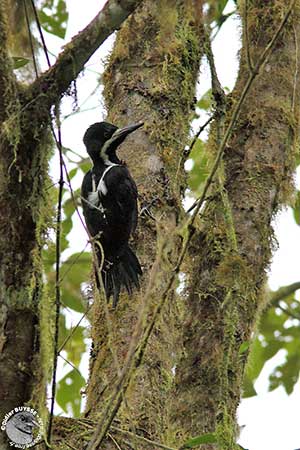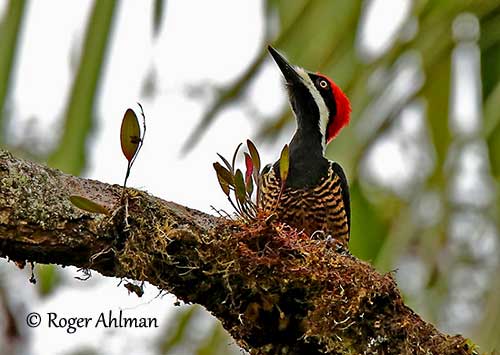
PROTECTION / THREATS / STATUS:
The Powerful Woodpecker is threatened by habitat loss through deforestation and agriculture expansion, especially in Venezuela. The species is local in Colombia, and rare or uncommon in Ecuador. It is rare in Peru.
This species occurs in protected reserves and national parks and the population is apparently stable.
The Powerful Woodpecker is currently evaluated as Least Concern.
Fr: Pic puissant
Ang: Powerful Woodpecker
All: Zimtbindenspecht
Esp: Picamaderos Poderoso - Carpintero Gigante - Carpintero poderoso
Ita: Picchio possente
Nd: Bruingebandeerde Specht
Sd: inkaspett
Photographers:
Roger Ahlman
Pbase Galleries Peru and Ecuador & My bird pictures on IBC
Didier Buysse
Vision d’Oiseaux
Text by Nicole Bouglouan
Sources:
HANDBOOK OF THE BIRDS OF THE WORLD Vol. 7 by Josep del Hoyo-Andrew Elliott-Jordi Sargatal – Lynx Edicions – ISBN: 8487334377
A GUIDE TO THE BIRDS OF COLOMBIA by Steven L. Hilty and William L. Brown - Princeton University Press – ISBN 069108372X
WOODPECKERS, an identification guide of the woodpeckers of the world by Winkler Hans and Christie David – Helm – ISBN: 0395720435
Woodpeckers of the World: The Complete Guide by Gerard Gorman – Editeur: A&C Black, 2014 – Helm
Photographic Guides - ISBN: 1408147173, 9781408147177
BIRDS OF PERU by Thomas S. Schulenberg, Douglas F. Stotz, Daniel F. Lane, John P. O’Neill, Theodore A. Parker III – Princeton University Press 2007–ISBN: 978-0-691-13023-1
BIRDS OF VENEZUELA by Steven L. Hilty – Ed. Christopher Helm – ISBN: 0713664185
First description of the eggs and nestlings of Powerful Woodpecker (Campephilus pollens)
Libro Rojo de la Fauna Venezolana – Carpintero gigante
WIKI AVES de Colombia - Campephilus pollens - Powerful Woodpecker
Powerful Woodpecker
Campephilus pollens
Piciformes Order – Picidae Family
INTRODUCTION:
The Powerful Woodpecker is a large, robust woodpecker in the genus Campephilus that includes the largest black woodpeckers. Because of their large size, they have to do more than most Picidae to maintain their hold on a vertical support. Their legs are directed more outwards while clinging to the tree trunk, and all four toes are directed forwards.
The Powerful Woodpecker frequents the humid forest at high elevation in the Andes in Colombia, Venezuela, Ecuador and Peru.
This species is described as uncommon throughout the range, but it is not currently threatened.

DESCRIPTION OF THE BIRD:
Biometrics:
Length: 32-35 cm
The Powerful Woodpecker adult male has black upperparts including the head (except the red crest), hindneck, mantle, scapulars and upper back. A white stripe extends from the base of the bill, down to neck sides to sides of back where it converges to form a white V. Lower back and rump are white, whereas the uppertail-coverts and the uppertail are black. On the black upperwing, the primaries show narrow white tips. The secondaries have white spots or bars on the inner webs, like on the outermost primaries.
On the underparts, chin, throat and central breast are black. Rest of underparts from lower breast to undertail-coverts are cinnamon-buff with black bars or chevrons, usually less distinct on belly. The underwing is blackish and barred white, and the underwing-coverts are white.
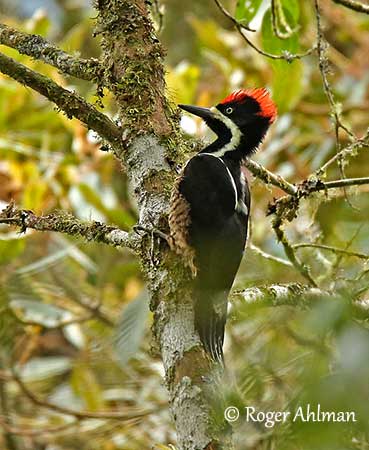
On the head, forehead to crest is bright red. The black and white bases of feathers are sometimes visible. Lores, eye area and ear-coverts are black, and a white band extends from the bill base to neck and back, ending in a white V.
The long, black, chisel-tipped bill is broad across the nostrils. The eyes are white. Legs and feet are dark grey.
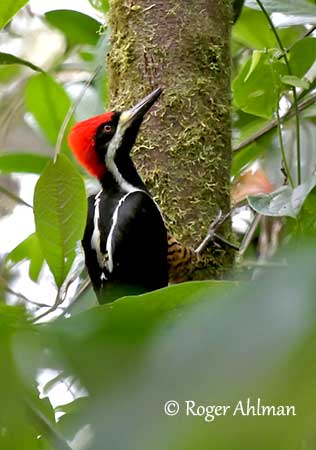
The female resembles male but on the head, the red is replaced by black.
The juvenile is duller, usually browner than adults. The back shows more barring. The underparts are greyer with broader barring. The head pattern is similar to adults, but the crest feathers are longer.
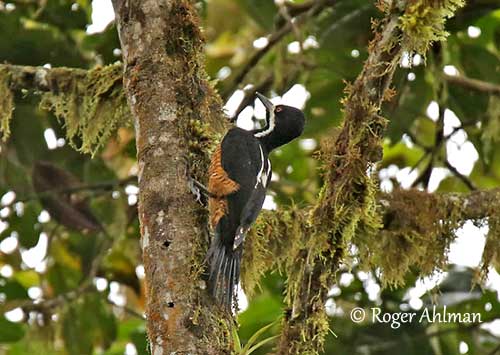
SUBSPECIES AND RANGE:
The Powerful Woodpecker has two subspecies.
C.p. pollens (described above and displayed) is found in the Andes from NC Colombia and SW Venezuela (Táchira) S to Ecuador.
C.p. peruvianus occurs on E slope of Andes in Peru (S to Junín).
This race has cinnamon-buff (not white) lower back and rump, often strongly barred. It may have narrow cinnamon bars on the uppertail-coverts.
HABITAT:
The Powerful Woodpecker frequents humid, wet forest, cloud forest and edges, mature forest, second growth and open woodland.
The species occurs mainly between 1,700 and 2,600 metres of elevation, but it can be seen from 900 metres to 3,750 metres according to the range.
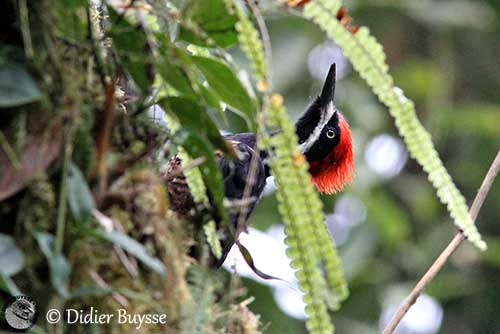
CALLS AND SONGS: SOUNDS BY XENO-CANTO
The calls of the Powerful Woodpecker include a high, squeaky “psit”, but it also gives a longer rattle “psit-trr-r-r-r”.
In flight, it gives a fast “kikikikikawh” becoming more descending when the bird is excited “kikikiki-keh-keh-kah-kah”.
A loud, reedy and stained “udd-daa-da-da” is distinct among Campephilus species.
This large woodpecker has a heavy drum of 2-4 strikes, rendered as a double rap.
BEHAVIOUR IN THE WILD:
The Powerful Woodpecker’s diet is poorly known. However, the Picidae feed primarily on insects and larvae and various arthropods, with in addition some nuts, acorns and fruits.
The food is usually obtained from dead or rooting wood, by probing deeply into holes and bark crevices. It also probes for insects into the luxuriant coat of mosses and lichens covering the tree trunks in the cloud forest.
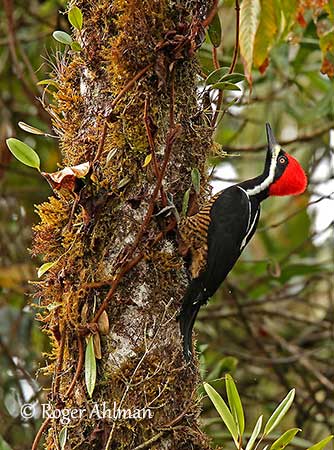
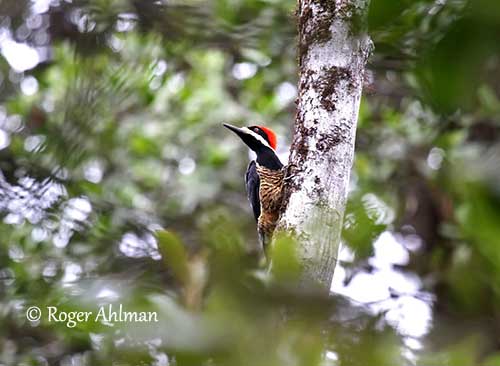
This large woodpecker climbs to the trunk with the legs directed outwards, and with all toes pointing more or less forwards. The stiff tail feathers allow it to keep the balance.
The breeding behaviour of the Powerful Woodpecker is poorly known. However, like most woodpeckers, this species nests in cavities, usually a hole excavated in tree trunk. Both adults apparently share the nesting duties.
Drumming can be heard, used as signal to advertise their presence. The displays probably involve the raising of the red crest feathers, and some postures may enhance the white V and rump while the wings are drooped. No more information.
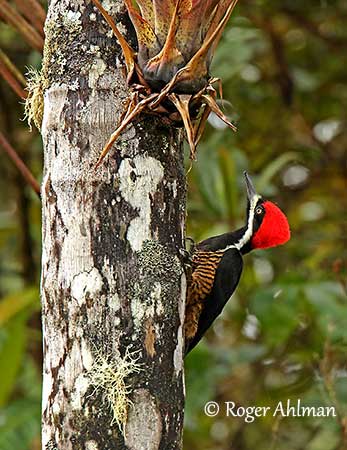
The Powerful Woodpecker is resident.
In flight, the white rump is conspicuous like the broken white bars across the flight-feathers and the white underwing coverts. The flight is undulating with active wingbeats interspersed with glides.
REPRODUCTION OF THIS SPECIES:
From an observation in NE Ecuador, the nest and the breeding biology of the Powerful Woodpecker are described.
The species nests in cavity excavated in tree trunk, placed between 5,5 and 14 metres above the ground for the two studied nests. One nest was found in October 2002 and a second nest in May 2008. The cavities were unlined, or only with wood chips. They were excavated in dead trunks at the edges of the primary forest.
The female lays two all-white eggs. The incubation may last 16 to 19 days and apparently both adults share this period.
At hatching, the chicks are naked and their skin is pink. They fledge 34-37 days after hatching. At 33 days old, the young resembles adults but it has dark eyes.
This species could have two well-defined breeding peaks in the year. But more information is required.
